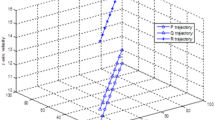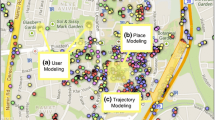Abstract
Context-awareness is viewed as one of the most important aspects in the emerging pervasive computing paradigm. Mobile context-aware applications are required to sense and react to changing environment conditions. Such applications, usually, need to recognize, classify and predict context in order to act efficiently, beforehand, for the benefit of the user. In this paper, we propose a novel adaptive mobility prediction algorithm, which deals with location context representation and trajectory prediction of moving users. Machine Learning (ML) is used for trajectory classification. Our algorithm adopts spatial and temporal on-line clustering, and relies on Adaptive Resonance Theory (ART) for trajectory prediction. The proposed algorithm applies a Hausdorff-like distance over the extracted trajectories handling location prediction. Since our approach is time-sensitive, the Hausdorff distance is considered more advantageous than a simple Euclidean norm. Two learning methods (non-reinforcement and reinforcement learning) are presented and evaluated. Finally, we compare our algorithm with Offline kMeans and Online kMeans algorithms. Our findings are very promising for the use of the proposed algorithm in mobile context aware applications.








Similar content being viewed by others
Notes
One possible approach to determine the initial k clusters is to select the first k distinct instances of the input sample U.
References
A. Dey, Understanding and using context, Personal and Ubiquitous Computing, Vol. 5, No. 1, pp. 4–7, 2001.
J. Hightower and G. Borriello, Location systems for ubiquitous computing, IEEE Computer, Vol. 34, No. 8, pp. 57–66, 2001.
E. Alpaydin, Introduction to Machine Learning, The MIT Press, Cambridge, 2004.
R. Duda, P. Hart and D. Stork, Pattern Classification, Wiley-InterscienceNew York, 2001.
E. Belogay, C. Cabrelli, U. Molter and R. Shonkwiler, Calculating the Hausdorff distance between curves, Information Processing Letters, Vol. 64, No. 1, pp. 17–22, 1997.
S. Choi, K. G. Shin, Predictive and adaptive bandwidth reservation for hand-offs in QoS-sensitive cellular networks, ACM SIGCOMM, 1998.
S. Hadjiefthymiades, L. Merakos, Proxies+path prediction: improving web service provision in wireless-mobile communications, ACM/Kluwer Mobile Networks and Applications, Special Issue on Mobile and Wireless Data Management, Vol. 8, No. 4, pp. 389–399, 2003.
A. Karmouch, N. Samaan and A. Mobility, Prediction architecture based on contextual knowledge and spatial conceptual maps, IEEE Transactions on Mobile Computing, Vol. 4, No. 6, pp. 537–551, 2005.
R. Viayan and J. Holtman, A model for analyzing handoff algorithms, IEEE Transactions on Vehicular Technology, Vol. 42, No. 3, pp. 351–356, 1993.
D. Ashbrook and T.Starner, Learning Significant Locations and Predicting User Movement with GPS, Proc. Sixth Int’l Symp. Wearable Computes (ISWC 2002), pp. 101–108, Oct. 2002.
I. Priggouris, E. Zervas and S. Hadjiefthymiades, Location based network resource management. In Ismail Khalil Ibrahim, editor. Handbook of Research on Mobile Multimedia, Idea Group IncHershey, 2006.
K.M.Curewitz, P. Krishnan, and J.S.Vitter, Practical Prefetching via Data Compression, In Proceedings of ACM SIGMOD, pp. 257–266, 1993.
K. Narendra and M. A. L. Thathachar, Learning Automata–An Introduction, Prentice HallEnglewood Cliffs, 1989.
R. Jain Cheng and E. van den Berg, Location prediction algorithms for mobile wireless systems, Wireless Internet handbook: technologies, standards, and application, CRC PressBoca Raton, 2003. pp. 245–263.
G. Yavas, D. Katsaros, O. Ulusoy and Y. Manolopoulos, A data mining approach for location prediction in mobile environments, Data and Knowledge Engineering, Vol. 54, No. 2, pp. 121–146, 2005.
D. Katsaros, A. Nanopoulos, M. Karakaya, G. Yavas, O. Ulusoy and Y. Manolopoulos, Clustering mobile trajectories for resource allocation in mobile environments, In Proceedings IDA, pp. 319–329, 2003.
Y. Tao, C. Faloutsos, D. Papadias and B. Liu, Prediction and Indexing of Moving Objects with Unknown Motion Patterns, ACM SIGMOD, 2004.
V.T.H. Nhan and K.H. Ryu, Future Location Prediction of Moving Objects Based on Movement Rules, Springer ICIC, LNCIS 344, pp. 875–881, 2006.
Y. Xiao, H. Zhang, H. Wang, Location Prediction for Tracking Moving Objects Based on Grey Theory, IEEE FSKD, 2007.
Author information
Authors and Affiliations
Corresponding author
Rights and permissions
About this article
Cite this article
Anagnostopoulos, T., Anagnostopoulos, C. & Hadjiefthymiades, S. An Adaptive Machine Learning Algorithm for Location Prediction. Int J Wireless Inf Networks 18, 88–99 (2011). https://doi.org/10.1007/s10776-011-0142-4
Received:
Accepted:
Published:
Issue Date:
DOI: https://doi.org/10.1007/s10776-011-0142-4




